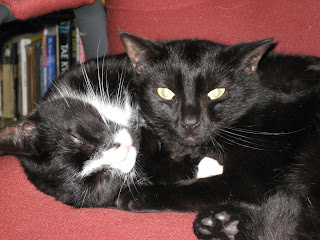The stigma surrounding cats, especially black cats, has long been associated with evil, black magic, witchcraft and superstition. Believers in the metaphysical often use caution around a number of things that are said to bring bad luck, and a black cat crossing their path is one of them.
These negative associations go back centuries, all the way back to Greek mythology.
In Ovid's tale, Galinthias was one of the servants of the mother of Hercules, Alcmene, and her attempts to help got her into quite the predicament.
Alcmene was the wife of Amphitryon. Zeus disguised himself as Amphitryon in order to have relations with Alcmene and she became pregnant. Zeus's wife, Hera, became furious and tried to prevent the birth. Galinthias got involved by playing a trick on Hera which enabled Alcmene to successfully give birth to Hercules. Hera took her revenge on Galinthias by turning her into a cat and sending her to the underworld. She was to act as a priestess of Hecate, the goddess of death and the queen of witches. Because of the connection with Hecate, black cats were then thought to be an omen of death and associated with witchcraft.
The word for 'the fear of cats' is ailurophobia. This came from the name Ailuros, which was the Greek name for the ancient Egyptian goddess Bast. The Greeks saw Bast as a version of their lunar goddess Artemis. It was said that Artemis turned herself into a cat in order to escape the god of wind, Typhon,
During the Middle Ages, superstitions around black magic were abundant, and black cats were targeted. Pope Gregory XI had published the "Vox in Rama" document in 1233 to deal with the subject of devil worship. He claimed that black cats were the incarnation of Satan, therefore, throughout the next century black cats were slaughtered.
Interesting is that with the killing of cats, the rodent population escalated which helped spread the bubonic plague during the 14th century killing millions of people. Pope Gregory may have been long dead by then but superstitions stick and even to this day people associate cats with scorcery.
During the witch hunt era, 1450 to 1750, black cats were seen as being such evil companions to their "witches" that they were burned in baskets alongside their owners.
The trend of labeling black cats as evil came to the United States with the Pilgrims in the Plymouth colony. The Puritan Pilgrims distrusted anything associated with sorcery and actively persecuted black cats just for being the color black. It became a practice to burn black cats on Shrove Tuesday to protect the home from fire.
As time passed and this practice died down, black cats had become part of all the legends behind witches. As the celebration of Halloween became more commercial, black cats became part of the usual Halloween decorations. The bristled fur, claws and green eyes just added to the desired spooky effect.
Animal shelters are very aware of the concern with people wanting to adopt cats around Halloween just to use them in satanic rituals or sadistic pranks. Back in the 1980's and 90's there were restrictions on adoptions in the weeks leading up to Halloween. Today those concerns are still present, however, due to the need for homes with the abundance of cats in shelters, those bans are no longer in place. Adopting black animals in October has even become a promotional tactic to increase awareness of the need for homes for these pets.
The kitty pictured above may look terrifying, but in reality she is just our Bella letting me know she is hungry!










